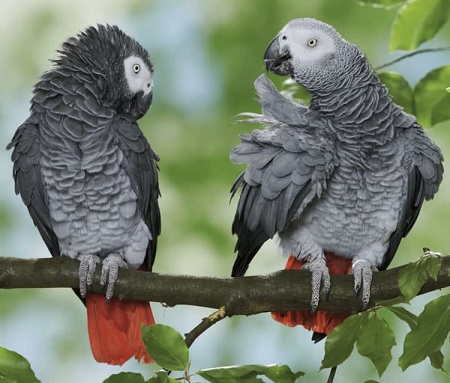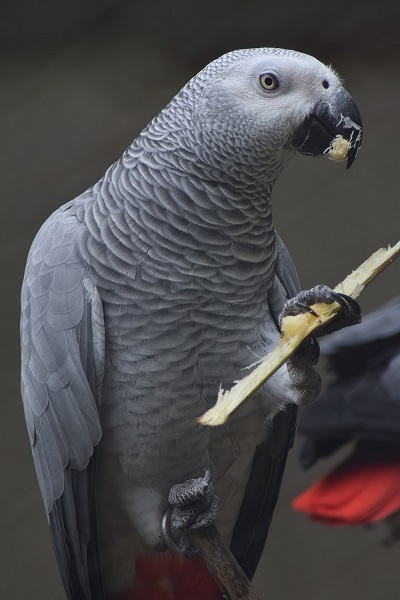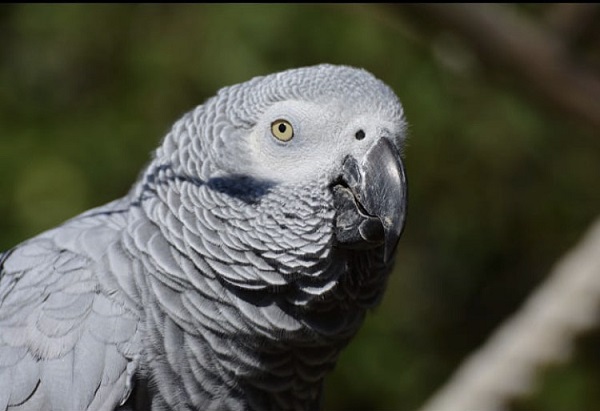I presume you will agree with me on this about an African grey parrot when I say:
As an avian pet parent, it’s So Difficult to master the fundamental guides.
Or is it?
Well, it turns out, that you can radically optimize your success rate in the key result areas. Literally, by acting now on key result areas like diet & feeding, habits & behaviors, intelligence & mimicking, basic & veterinary care, and mating…
…you can guarantee a happy life for both you and your parrot.
And in this post, I’m going to show you simple actionable steps to follow…and exactly how you can easily implement them, alright!

What Are Some Interesting Facts About African Grey Parrots
Is an African Grey a Parrot?
According to dlab, the African Grey Parrot is a medium-sized parrot of the genus Psittacus, native to Africa. As the name implies, they are predominantly grey, with accents of white. Some of their feathers are very dark grey and others are a lighter grey color. They have red or maroon tails depending on the subspecies. African greys feed primarily on nuts and fruits, supplemented by leafy matter.
Where Do Grey African Parrot Live?
According to NatGeo, the African grey is native to rainforests of central Africa. Clearly ranging in a band across the continent from Côte d’Ivoire to western Kenya.
How Many Types of African Grey Parrots Are There?
There are two subspecies:
- Firstly, the Congo African Grey, Psittacus erithacus erithacus – these are larger birds (about 12 inches/30cm long). With light grey feathers, deep red tails, and black beaks.
- Secondly, the Timneh African Grey parrot, Psittacus erithacus timneh – these are smaller in size. Also, they have a darker charcoal gray coloring, a darker maroon tail, and a light, horn-colored upper mandible.
Allegedly, some avian enthusiasts recognize a third subspecies, the Ghana Grey Parrot(Psittacus erithacus princeps). This bird is described to be similar to the Congo grey parrots, but darker and slightly smaller. However, scientifically this subspecies is not recognizable. Commonly among breeders, there is said to be a fourth subspecies, the Cameroon Grey Parrot, referred to as the big silvers.
How Can You Tell if a Grey Parrot is Male or Female?
For the female, the lines right on the edge of the wings are more pronounced, while those for the male are darker. Also, in the males, the bottom red tail has some definite dark color, whereas the tail of the females is just red. Furthermore, the female’s wings clearly go beyond the tail, while the wings of the males are shorter than the tail.
Can I buy a Congo Grey Parrot?
Yes, you can!
Primarily, there are many elite breeders of African grey breeders online. However, you must ensure you carry out proper research just so you can make an informed buying decision. Click here to read this revelatory post about African Grey Parrot For Sale – Secrets To Know Before Buying. Herein, you’ll find a proper guide on how to search and identify a reputable African grey breeder. Importantly, Click on the image below to view our Available Parrots.
Do You Need a License for an African Grey Parrot?
Apparently, grey parrots are now on Appendix 1 of CITES. So, you need an Article 10 certificate, which permits you to breed and sell them.
CITES stands for Convention on International Trade in Endangered Species of Wild Fauna and Flora. It is an international agreement between the world’s governments. Notably, the aim is the protection of natural wildlife and the trade of specimens to the detriment of world populations.
What is the Difference Between Captive-Born / Hand-Raised and Wild-Caught Grey Parrots
As obtained from dlab, some avian pet owners often liken the experience of keeping an African grey to raising a young child. Allegedly, both for their intelligence and for the substantial time commitment which they require. While captive-born and hand-raised grey parrots bred by avian breeders usually assimilate into their new households with relative ease.
Conversely, wild-caught grey parrots require considerably more time to adapt to living with humans. In addition, they have a tendency to growl and bite when they are approached. The Convention on the International Trade in Endangered Species ( CITES) has rendered all sales of wild-caught Congo grey parrots illegal.
Intelligence and Mimicking Ability
Objectively, relative judgments of animal intelligence are usually not easy to make. Indeed, animal intelligence has been studied for years. Notably, birds are often the smartest animals with profound cognitive abilities. Even so, some parrot species often kept as pets have been shown to be smarter than others.
On the subject of animal intelligence, African greys are the most heavily studied species of avian pets. Demonstratively, they are noted for their cognitive abilities. Practically, it is believed to have evolved due to their history of cooperative feeding on the ground in central Africa.
Can Grey Parrots Understand English?
Reference to Dr. Pepperberg's Extensive Research
In reference to Dr. Irene Pepperberg’s extensive research with one of the most famous African Grey Parrot named, Alex. Sadly, he passed away in 2007 at the young age of 31 years. Notably, he was purchased from a pet store by Dr. Pepperberg at the age of one. Pepperberg was a doctoral student at the time. Marvelously, he cared for and studied him throughout his entire life. Further, Dr. Pepperberg’s research proves that African greys are capable of associating human words with their meanings. Well, at least to some extent.
Remark on Dr. Pepperberg's Research
How Many Words Can African Grey Parrots Learn?
For the most part until his death, Alex learned over 100 English words. Genuinely, he was considered to have the intelligence level of a five-year-old. Pertinently, until Alex, most research on avian intelligence was done using pigeons. Simply needless to say how disappointing it was. Profoundly, Alex changed most people’s thoughts on the African grey’s learning capacity and capabilities.
Critics of Dr. Pepperberg's Research
Although critics of Alex’s studies argue he may have simply been a product of operant conditioning and not true understanding. However, even if it was simply a trained response, Alex’s abilities far surpass anything most birds have ever achieved. Intriguingly, as a result of Alex’s research, the African grey parrot now has a reputation for being quite a smart avian pet. And most importantly, they need constant mental stimulation.

How Do African Greys Communicate?
Naturally, African grey parrots communicate by adjusting the air that flows over the syrinx to make sounds. The syrinx is situated where the trachea splits into the lungs. Demonstratively, they are remarkably great at emulating human words and sounds.
Progressively, claims of language use have also been made for another African grey, N’kisi. Reportedly, he had a vocabulary of over 1000 words and spoke in sentences. A lot of debates exist on how well they actually understand the meaning of the words they speak. There is little doubt that African grey parrots communicate through words and sounds.
At What Age Does Grey African Parrots Start Talking?
Generally, African grey parrots start talking around the age of 12-14 months. Repeatedly, they tend to mimic the sounds and words they frequently hear in their environment. Usually, most avian pet owners and lovers are anxious about when exactly their African grey would start talking. Moreover, they are even more curious about what sort of vocabulary it would have. Notably, the more words you speak to your African grey, the higher their probability to mimic them over time.
Habits and Behaviors
What are the Habits of African Greys?
According to Britannica, African grey parrots prefer lowland rainforest through most of their range, venturing into surrounding savanna. Also, the mangroves and agricultural land in search of food. In a like manner, they prefer to forage in groups of usually fewer than 50 birds in the wild.
Furthermore, they are largely frugivorous, eating seeds, nuts, and fruit from multiple genera, including Bombax, Ficus, Macaranga, and Raphia. Above all, the African grey has a special preference for the fruit of the oil palm. Literally, it supplements its diet with flowers, bark, and invertebrates, including insects and snails.
Often, they descend to the ground to ingest clay and soil, probably for nutrients and antiparasitic compounds. Furthermore, when foraging in trees, it prefers to use its beak and feet to climb between branches rather than flying.
As pets, they are very sociable and playful and enjoy climbing and chewing. In addition, they love mimicking the sounds and words they hear around them.
What are the Behavior Problems with African Greys?
Naturally, African grey parrots are smart birds that love being busy. So, when bored, they present behavioral problems like destructive feather picking.
Commonly, they also tend to display other behavioral issues like extreme vocalization, improper noise, and screaming.
What Do Grey Parrots Love?
Essentially, African grey parrots love leafy greens, fruits, and vegetables. So, this includes fruits like organic mango, pomegranate, and melon. More so, vegetables like arugula, kale, and sprouts, as well as nutritious seeds like hemp and flaxseed.
Now, if you own one, it’s important to ensure fruits, vegetables, nutritious seeds, and leafy green constitutes a major part of your parrot’s diet plan. While high-quality pellets may be a supplement. Above all, ensure your parrot frequently has fresh, clean water available.
Do African Greys Like Humans?
Innately, African grey parrots are highly sociable and intelligent with a good sense of humor. In a like manner, this enables them to grow a solid bond with their owners. By the same token, they are incredibly attuned to their owner’s emotions and modes. Overall, African grey parrots like humans and other pets.

Do African Greys Recognize Their Owners?
Yes, African grey parrots do recognize their owners. Primarily, once they develop a bond with their owners, they will definitely often miss them when they are not around. Oftentimes, African greys become confused and traumatized by the presence of strange and unrecognizable people. Above all, they remember people and know who was kind and caring, and who was not.
Do African Greys Like to Be Alone?
African grey parrots are social and intelligent birds with a personality as opposed to other wordless birds. Quite often, they like being left alone in their cage where they can have their own private time. In essence, they are social animals similar to babies and toddlers.
Do African Grey Parrots Sleep?
Yes, they do!
Similar to humans, African grey parrots’ sleep is highly influenced by light cues. Approximately, they need 10 – 12 hours of night sleep. As noted by Ken Welle, DVM, an avian veterinarian who practices in Illinois, African greys are tropical or subtropical. Meaning they live near the equator where there are 12 hours of darkness every night.
Do African Greys Get Jealous?
The simple answer is yes. Indeed African grey parrots are innately emotional birds both in domestic settings and in the wild. Every so often, when this happens, they become noisy and maim feathers, or even exibit other negative behaviors. Also, smaller birds may often become jealous of another bird in the household, one of their own toys, or even a family member.
However, with the right procedures, it is likely to calm the tension and counteract your parrot’s jealousy.
Can Congo Grey Parrots Recognize Themselves in the Mirror?
When in front of the mirror, African grey parrots are most likely to approach the mirror. However, that’s not evidence of mirror self-recognition. Interestingly, there are a couple ongoing studies on self-recognition with African greys. Hopefully, the results prove something more clarifying than those from previous studies.

Your Security Matters! Pet Scams, How to Avoid Them When Buying an African Grey Parrot
Why Do African Greys Bite?
Inherently, when they feel threatened in any way, they tend to bite as self-defense. Interestingly, you can earn the trust of an African grey parrot with patience and respectful interaction. Most importantly, there’re other causes of agression in African grey parrots. For instance territoriality and dominance issues, hormonal fluxes during adolescence or breeding season, stress, lack of mental stimulation.
How Do I Make My Grey Parrot Happy?
Quite simply, daily dancing, playing, talking, training, and just being in the same room would avail the adequately needed social interaction. Above all, African grey parrots need some daily hours of refreshing playtime with their owners, family members, and other pets. So, this may involve games like puzzles and exercises. As well as out-of-cage time that helps to build their social muscles, and makes them happy.
How Do I Know if My African Grey is Cold?
Commonly, your African grey parrot display signs of cold by screwing up its feathers, while submerging its beak into its chest. In addition, it will shiver and cringe to cover its legs in its feathers. Furthermore, it may also experience lack of movement, heavy breathing with fluid from the eyes and nose, lethargy, and loss of appetite.
How Do I Know if My Grey Parrot is Healthy?
If your African grey is healthy, it should display the following signs:
- Clean and dry nostrils.
- Bright and alert eyes.
- The beak should be strong with no overgrowth, fractures, or asymmetry.
- Bright cere colors without overgrowth.
- Engagement and attentiveness.
- Shiny, smooth, and vibrant feathers.
- The mouth interior should look clean, with no unpleasant smell.
- Maintainance of healthy weight. Train your parrot to be weighed once a week.
- Ensure to check their grip by giving them a finger to stand on.
- Ensure to check for ectoparasites, stress lines on feathers, abnormal growth, broken feathers, pin feathers, feather plucking, and feathers stuck in a molt.
- The feet should be moving freely on both legs, with no nail overgrowth, missing toes, or excessive build-up of feces. The base of the feet has small ridges and no evidence of pododermatitis.
- Recommendedly, your parrot should the appropriate quantity of food twice a day.
How Do Congo Grey Parrots Show Affection?
Fundamentally, African grey parrots show affection by leaning. They’re sociable birds who tend to brush their soft feathers against your skin while leaning into you with their head against your hand. More so, when your parrot flies straight into your arm with you calling indicates how Congo grey parrots show affection.
How Do I Know if My African Grey Likes Me?
Your African Grey parrot can let you know it likes you in several ways. For instance, if your parrot nibbles your hair, shirt, or ear, and cuddles with you, it indicates that it likes you. And it will preen itself. Normally, they don’t preen themselves unless they feel comfortable in their surroundings. If you notice your parrot preening its feathers in your company, it’s right to say that it trusts you and feels secure in your presence.
In addition, your parrot will groom you, sounds funny, right? Well, in the wild, they inherently preen each other as a sign of care and affection. As pets, they often don’t have another parrot to preen. As a result, they tend to do it with whom they are closely bonded. If your grey parrot chews on your hair, ear, shirt, or anything else on your body, it’s a vital sign that they like you.
How Do I know if My African Grey Parrot is Stressed?
If your grey parrot displays a sudden change in attitude and tends to be hostile, it’s probably a sign of stress. Consequently, extreme screaming, fizzling, pouncing, and gripping are all indicators of stress to beware and be aware of.
How Do You Train an African Grey Parrot to Sit on Your Hand?
With a target stick in your hand, approach the African grey parrot not from below nor from above. Then, hold the target stick in front with your hand and move them together so that they move at the same distance. Note that the parrot has to get on your hand to touch the stick. It’s like the stick is glued to the hand, but just at a distance that he has to be on your hand to reach the stick.
Diet and Feeding
What Does Congo Grey Parrot Eat?
African grey parrots love leafy greens, fruits, and vegetables. This includes fruits like organic mango, pomegranate, and melon. Additionally, vegetables like arugula, kale, and sprouts, as well as nutritious seeds like hemp and flaxseed.
Hence, if you own one, it’s important to ensure fruits, vegetables, nutritious seeds, and leafy green constitutes a major part of your parrot’s diet plan. While high-quality pellets may be a supplement. Above all, ensure your parrot frequently has fresh, clean water available.
What is a Grey Parrot's Favorite Food?
Similar to other parrots, the African grey feeds on a variety of foods, which makes it difficult to pinpoint what its favorite food is. But they generally love foods like seeds, pellets, grains, nuts, fruits, vegetables, weeds, flowers, and supplements.
Note, that your first decision would be whether pellets or seeds would serve as its base diet. Basically, in the wild, they feed on seeds, not pellets. Thus, we recommend that fruits, vegetables, nutritious seeds, and leafy greens constitute 80% of your parrot’s diet plan. Nonetheless, other breeders would probably recommend a different plan, but we recommend an effective plan that’s proven in our breeding program.
How Many Times Should I feed My Grey Parrot?
Essentially, your Congo grey parrot should be fed at least twice and at most thrice a day.
How Much Water Should a Grey African Parrot Drink?
Similar to other mammals, a Congo grey parrot needs enough water for their normal functionality. Recommendedly, they should drink water that is proportionate to 5% of their body weight. Importantly, weather hugely influences the quantity of water an African grey parrot drinks because water is required to sustain hydration.
What Fruit Congo Grey Parrots Eat?
Commonly, Congo grey parrots eat fruits like cherries, mangoes, apples, bananas, apricots, pawpaws, watermelons, plums, oranges, pomegranates, blueberry, guava, blackberry, and grapes. Literally, you may serve your African grey with any fruits available.
Can Grey Parrots Eat Rice?
Safely, grey parrots can all varieties of rice like brown rice, basmati rice, white rice, jasmine rice, and sticky rice. Technically, brown rice holds more selenium, magnesium, manganese, fiber, vitamin B9, and antioxidants than white rice.
Can African Greys Eat Meat?
Definitely! In the wild, Congo grey parrots have an intake of grubs, fish, caterpillars, and carrion. Moreover, as pets, they commonly eat cooked fish, cheese, eggs, and chicken. So, they certainly eat meat.

Can Grey African Parrots Eat Bread?
Technically, grey African parrots can eat low-salt whole wheat bread. However, you should only consider it as an occasional treat since bread isn’t nutrient-rich anyway.
Did You Know?
Click here to read more on Toxic Foods For Parrots -Top 7 To Never Feed Your African Grey
Can African Grey Parrots Eat Raw Carrots?
Absolutely! Particularly, Congo grey parrots love the crispy texture of raw carrots. Besides the raw form of carrots, they also eat cooked, baked, boiled, or steamed carrots with low salt. In addition, they can also eat other vegetables like tomatoes, maize, spinach, collard greens, cabbage, chilies, pumpkins, and asparagus.
What Herbs Can Congo Grey Parrots Eat?
Yes, they can!
Congo grey parrots can eat popular herbs with vitamins and antibacterial and anti-inflammatory properties. These include herbs like coriander, dill, basil, mint, parsley, rosemary, thyme, and oregano. Notably, these herbs have a lot of health benefits and in their variety, they provide for a balanced diet.
How Can I Get My African Grey to Gain Weight?
Ideally, a weight gain dinner diet for your grey parrot would require you to serve it with some additional sunflower seeds. You may also serve them as regular daily treats. Remarkably, these sunflower seeds are tasty and rich in fat, which would help your parrot to gain weight.
Bathing & Showering
Should I Spray My African Grey Bird With Water?
Basically, you’d need to do an assessment with separate bathing methods to distinguish which one your grey parrot favors. Actually, some grey parrots relish a tender spray or mist, unlike others who may relish a shallow basin to dash around. In which case you may give them a shallow basin of water wherein they may plunge their feathers. As a result, only after your grey bird approves of spraying you should spray your bird with water.
Do Congo Grey Parrots Need to Bath?
Essentially, African greys need to bathe because it benefits their feathers to be in tip-top shape. Moreover, it helps their skin and feathers to look healthier and also helps them with molting and preening their feathers. Commonly, most grey parrots like bathing every day, but the frequency would depend on how your parrots respond to frequent baths.
How Often Should I Bath My African Grey Parrot?
Understandably, African greys in their natural habitat tend to take a bath daily. Contrary to that, as pets, they don’t need to take a daily bath. Factually, over-bathing may plunder their feathers of necessary oils, which might cause dryness and irritation. Ideally, a recommended healthy bathing regularity for your grey parrot should be at least once a week. Nonetheless, during the summer months, you could regulate it to 2 to 3 times per week.

Health & Vet Care
What Vitamins Should I Give My Grey African Parrot?
African greys have peculiar dietary requirements that require supplementary vitamins like Vitamin D3. Additionally, they need to be served with foods that are high in Vitamin A and Calcium for grey parrots like broccoli, mustard greens, cheese, leafy greens, and so on. Frequently, they need a planned quantity of vitamin and calcium supplements.
Importantly, be aware of the fact an excess of these vitamins and minerals in your grey parrot’s diet could cause health issues. Planning and moderation is a major keys.
What Antibiotics Do African Grey Parrots Take?
Recommendedly, a clinically ill African grey parrot ought to be treated with injectable or oral doxycycline and water (800 mg/L). In addition, formulations of doxycycline in the food or water and chlortetracycline-impregnated seeds or other foods are available to treat infected flocks.

Mating
What Age Do African Greys Start Mating?
Naturally, African greys are late bloomers are far as being mature for mating is concerned. Conventionally, in avian breeding homes, they become appropriately mature for mating at 7-10 years old.
Conversely, in the wild, they reach their climax for mating at 15-20 years old. Advisably, they should be rushed into mating and breeding below 7 years old, besides their rapid maturity in captivity.
How Long After Mating Do African Greys Lay Eggs?
Many times, African greys start mating in October. And it’s approximately a month after that the hen lays her eggs.
How Many Times an African Grey Parrot Lay Eggs a Year?
Recommendedly, an African grey parrot should only lay eggs twice a year. Consequently, you need to evict the nest box in between clutches and make certain that you don’t let her have a nest. Further, you should shift the cage to a more preoccupied position and keep shifting it if she shows signs of laying more eggs. Lastly, ensure you control her light for 8-10 hours.

Can African Greys Lay Eggs Without Mating?
Biologically, African greys can lay eggs without mating. Although a solitary female would only lay infertile eggs. Advisably, ensure that you increase your female parrot’s Calcium intake during laying. This is because egg-forming exhausts stored calcium and energy levels. It’s ideal to consult your avian vet on this.
How Long Does it Take for African Grey Parrot Eggs to Hatch?
On average, the incubation time span for a Congo grey parrot’s egg to hatch is 21-28 days. Also, the babies usually leave the nest about 80 days after hatching.
How Many Babies Can an African Grey Parrot Have?
In the wild, the grey parrot lays a clutch of about three to four eggs, which are incubated by the female. Although not generally confirmed, a female grey parrot can normally have three to four babies for the most.

How Many Times a Year Do African Greys Breed?
As a breeder, you could allow them to have two clutches a year. You’d need to permit them a six-month rest between each clutch. As such, breeding female grey parrots need a great deal of privacy and patience. They tend to screw up their debut clutch. Hence, patience is required and you shouldn’t be demoralized even if you don’t get chicks for the debut and even the second time out.
What Do African Grey Parrots Eat When Breeding?
It’s advisable for a female breeding grey parrot to feed on a calcium and vitamin-rich pelleted diet. They also love consuming soft foods, grains, sweet corn, and sprouts during breeding.
Can Two Male African Greys Live Together?
Dominance hierarchy is very common among male African greys. Precautionarily, you should ensure they each have their individual cage and play stands or alternative perches. Despite being the same species isn’t a guarantee they’d be friendly. With the right social pieces of training, they’d most probably live peacefully together.
Can Two Female African Greys Live Together?
Unlike males with dominant instincts, female African greys can easily live together, but not in the same cage. Unless you’re convinced of their tolerance and cuddling training.
Those are the Hidden Secrets You Need to Know About an African Grey. Literally, Petting an African Grey Parrot is One of the Marvellous Decisions of Your Life.
Importantly, go through our Available Parrot Page to find out more about our parrots ready to go now.
In addition, we have a benevolent African Grey Community you would find pleasure engaging with. It’s all about African grey owners being proud African grey parrot owners like they really should. Therein, we share amazing tips with each other, celebrating holidays, and playing games.
We appreciate you for reading and we say, Thank You!
Even if you do not eventually buy your African grey parrot from us. We still wish you the best. Once more, Thanks for Reading!!!
You May Also Like -
African Grey Parrot for Sale Near Me
African Grey Parrot For Sale – Secrets To Know Before Buying
African Grey Parrot Diet & Nutrition
African Grey Parrot Cage – Revealed Guides You Must Know
Toxic Foods For Parrots -Top 7 To Never Feed Your African Grey
Avoid Parrot Mills When Buying An African Grey
How To Avoid Pet Scam When Adopting An African Grey Parrot
Lifespan of African Grey Parrot. How Long Do African Greys Live?



